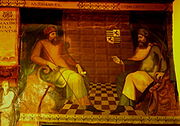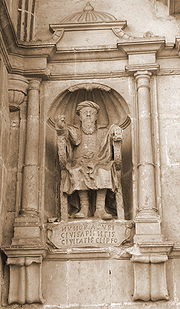
Nuño Rasura
Encyclopedia


Nuño Rasura was one of two legendary judges of Castile, the other being his son-in-law Laín Calvo. According to the Mocedades de Rodrigo
Mocedades de Rodrigo
The Mocedades de Rodrigo is the name given to a late, anonymous Castilian cantar de gesta, composed around 1360, that relates the origins and exploits of the youth of the legendary hero El Cid ....
, Nuño gained the nickname "Rasura" because "he took from Castile equal measures of wheat" to offer as a gift to Church of Saint James
Cathedral of Santiago de Compostela
Santiago de Compostela Cathedral is a Roman Catholic cathedral of the archdiocese of Santiago de Compostela in Galicia, Spain. The cathedral is the reputed burial-place of Saint James the Greater, one of the apostles of Jesus Christ. It is the destination of the Way of St...
. English medievalist Richard A. Fletcher
Richard A. Fletcher
Richard A. Fletcher was a historian who specialized in the medieval period. He was Professor of History at the University of York and one of the outstanding talents in English and Spanish medieval scholarship....
writes that "the legend of the judges has more to tell us of the Castilians' self-image at a later date than of the realities of the ninth century: they liked to think of themselves as sturdy, independent, resourceful, democratic."
The twelfth-century Liber regum and the Poema de Fernán González
Poema de Fernán González
The Poema de Fernán González is a Castilian epic poem, specifically, a cantar de gesta of the Mester de Clerecía. Composed in a metre called the cuaderna vía, it narrates the deeds of the historical Count of Castile, Fernán González. It was written between 1250 and 1266 by a monk of San Pedro de...
report that at the end of the ninth century reign of Alfonso II of Asturias
Alfonso II of Asturias
Alfonso II , called the Chaste, was the king of Asturias from 791 to his death, the son of Fruela I and the Basque Munia.He was born in Oviedo in 759 or 760. He was put under the guardianship of his aunt Adosinda after his father's death, but one tradition relates his being put in the monastery of...
(died 842), two judges were named to administer and defend the newly repopulating region that would become Castile. Nuño and Laín are described by the Poema as ancestors, respectively, of Castilian heroes Fernán González of Castile and El Cid
El Cid
Rodrigo Díaz de Vivar , known as El Cid Campeador , was a Castilian nobleman, military leader, and diplomat...
. The fullest account of the judges is given in Lucas de Tuy
Lucas de Tuy
Lucas de Tuy was a Leonese cleric and intellectual, remembered best as a historian. He was Bishop of Tuy from 1239 until his death....
(writing c.1236), who makes Nuño Rasura come from Catalonia
Catalonia
Catalonia is an autonomous community in northeastern Spain, with the official status of a "nationality" of Spain. Catalonia comprises four provinces: Barcelona, Girona, Lleida, and Tarragona. Its capital and largest city is Barcelona. Catalonia covers an area of 32,114 km² and has an...
. A prudent man, he convinced all the nobles of Castile to send him their sons that he might educate them. He ruled as far as the river Pisuerga. His supposed son, Gonzalo Núñez, was elected to succeed him on his death, and was given the title count. He is said to have married Jimena, daughter of Nuño Fernández, and to have been by her the father of Fernán González. Gonzalo was a just man and a good soldier, who waged many wars with the "tyrannical" Kings of León
Kingdom of León
The Kingdom of León was an independent kingdom situated in the northwest region of the Iberian Peninsula. It was founded in AD 910 when the Christian princes of Asturias along the northern coast of the peninsula shifted their capital from Oviedo to the city of León...
and the Moors
Caliphate of Córdoba
The Caliphate of Córdoba ruled the Iberian peninsula and part of North Africa, from the city of Córdoba, from 929 to 1031. This period was characterized by remarkable success in trade and culture; many of the masterpieces of Islamic Iberia were constructed in this period, including the famous...
.
It has been suggested that Nuño Rasura is to be identified with a historical Munio Núñez (named as Nuño Núñez in older histories), the early ninth century repoblador
Repoblación
The Repoblación was the ninth-century repopulating of a large region between the River Duero and the Cantabrian Cordillera which had been depopulated in the early years of the Reconquista....
who along with wife Argilo in 824 granted certain fuero
Fuero
Fuero , Furs , Foro and Foru is a Spanish legal term and concept.The word comes from Latin forum, an open space used as market, tribunal and meeting place...
s (charters of privileges) to the village of Brañosera
Brañosera
Brañosera is a municipality located in the province of Palencia, Castile and León, Spain. According to the 2004 census , the municipality has a population of 284 inhabitants....
. These grants were confirmed by the later Counts of Castile, the claimed descendants of Rasura. Munio and Argilo are thought to have been grandparents (or more distant ancestors) of Castilian counts Munio Núñez of Castrogeriz and Roa, Gonzalo Fernández of Lara and Nuño Fernández of Amaya, as well as of Muniadomna Núñez, queen to García I of León
García I of León
García I was the King of León from 910 until his death and eldest of three succeeding sons of Alfonso III the Great by his wife Jimena....
.

